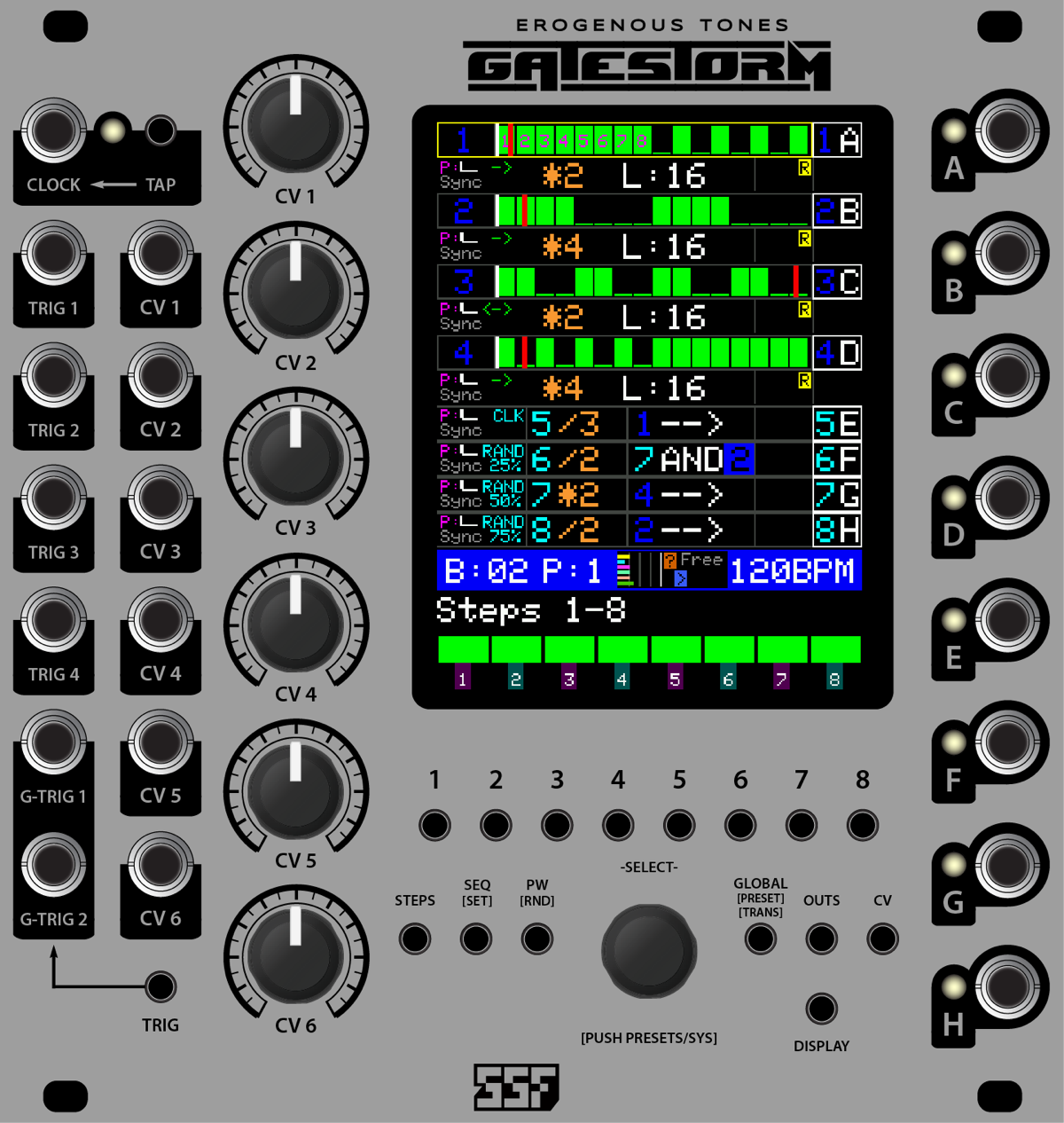GATESTORM
Advanced Gate Generator
GATESTORM, a collaborative module from Erogenous Tones and Steady State Fate, is designed to be an advanced Gate Generator with a highly flexible CV system with as much depth as you are willing to go. GateStorm was designed to be fun, intuitive, and more importantly, powerful. Don’t be overwhelmed by how much information is shown to you on it’s integrated display, once you start using it, you will see just how important and useful seeing that much information becomes.
While we are putting together videos to demonstrate all the functionality, design, and use of GateStorm, here are some highlights of most of the features:
Update to GATESTORM version 3.1 Firmware
Download GATESTORM Manual version 1.2
Click here to watch GATESTORM video series
Overall Features:
- 8 Gate Generators (4 Complex Lanes & 4 Simple Lanes)
- 7 Gate Inputs
- 1 Clock Input for Syncing GateStorm to an external clock
- Includes TAP TEMPO button as well
- 4 Local Gate Inputs
- 2 Global Gate Inputs (1 with integrated button to use when not patched)
- 6 CV Inputs with Attenuator (Normalized to DC voltage)
- 8 Gate Outputs (0-10V) with Integrated White LEDs
- 320×240 High Contrast LCD screen
- 1 Rotary Encoder with Pushbutton for Data Entry
- 15 Buttons for Various Parameter Entry
- USB connection on rear for Firmware Updating
- 24 HP
- Skiff Friendly (Very shallow)
- Power: +12v/-12v
- Current: 110mA +12v/ 20mA -12v
- Based on ChibiOS RTOS
Features Detail:
- Common Features for Lanes:
- Time base settings from /16 to *16 off master clock rate
- Pulse Width settings form 1/32 to 1/1 (1/32 can be used for trigger)
- Sync or Free running
- Sync mode means changes ONLY occur at master clock boundaries
- Complex Lane Features:
- 1-16 Step Length
- Forward, Backwards, Palindrome or One-Shot Operation
- Simple Lane Features:
- Clk Density Function (Full Clock, or between 0% to 95% random)
- Logic Operations with ALL 8 Channels
- Invert any channel
- AND, NAND, OR, NOR, XOR, XNOR
- Fully Customizable CV Matrix (Any CV to any INDIVIDUAL Lane Parameters:
- Common Lane CV/Gate Destinations:
- Pulse Width
- Time Base
- Global Reset Trigger
- Global Random Trigger
- Global Transport Pause
- Complex Lane CV/Gate Destinations:
- Rotate Steps
- Length Steps
- Local Trigger Reset
- Local Trigger Random
- Simple Lane CV/Gate Destinations:
- Logic Mode
- Source A
- Source B
- Density
- Global CV/Gate Destinations (Outside of Single Lane Settings):
- Rotate Outputs
- (Also has output locking to prevent certain lanes from rotating)
- Preset Changing
- CVBus (Used Mungo/MacroMachines Mechanism)
- Absolute CV Value (Preset 1-8)
- Incremental CV Value (Steps presets, 1,2,3,4 in circle, wraps around)
- Global Trigger Reset (Resets ALL lanes)
- Global Trigger Random (Randomizes ALL lanes)
- Global Trigger Pause (Pauses Only Lanes with Pause Active)
- Additional Features of Note:
- 10 to 400 BPM
- 16 Banks of 8 Presets Each
- (Last Bank Used Loads on Restart)
- Shallow Menus, All Functions Labelled (Most 2 deep)
- Template System (8 Templates) for Creating Custom Starting Points
- Template 1 is used as Reset Values for System
- Macro functions to speed up making changes (or copying values across lanes)
- Global operations to change settings for all lanes at once.
- Transport control for stop/start/pause on selected lanes
- Lanes can be muted from one of the menus
- Random system PER patch, FULLY flexible PER lane:
- Complex Lane Steps can be Full random, Euclidean or Euclidean with Offset.
- Random Setting Matrix Page makes for easy visual of random settings
- Random constraint system allows controlling WHICH enumerated random values are selected from.
- Mod Matrix page shows ALL modulations (in real time) for easier configuration
- CV graph on main page for easily seeing CV values coming in unmodified
- CV value range of effect can be set PER modulation, both positive OR negative
- Entire CV/Trig system can be disabled for making changes and not having the system changing modulations like patch switching at the same time.
- System Settings:
- Built in System clock divider to handle faster system clocks
- Clock averaging settings (takes multiple samples) smooths out syncing of the clock (can do 1, 2, 4 or 8 samples)
- ADC Smoothing, Slewing and Hysteresis System. Can be tuned for user expectation.
- Step/Wiper color schemes
- Display Brightness Settings
GateStorm has been retired, but you can likely find one out there!

